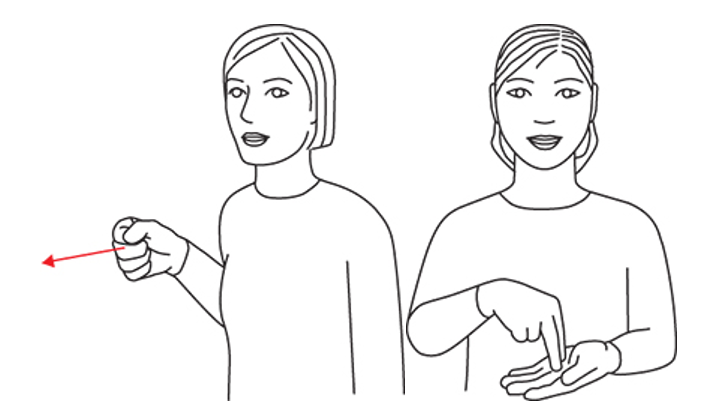Denne posten handler om tegnspråk. Jeg tror, derfor, det er viktig til å oversette det til tegnspråk (se nedenfor). Samtidig, jeg er ikke så flink på norsk tegnspråk ennå, har du spørsmål eller er du forvirret om noen? Gi beskjed, jeg skal prøve til å forklare!
Many signs in signed languages look the same because their iconic motivations are the same. I'm thinking here of SLÅ 'hit', or STÅ 'stand' (below). In both cases, it is extremely unlikely that NTS borrowed from ASL given what we know of the history between the two languages. In both cases, the concept is so basic that these signs would have been created independently long before users of ASL and NTS came in regular contact with each other.

To be clear, I'm not talking about loans from spoken language into a signed language. Most sign language courses discuss this at some point - it's interesting, but not what I want to talk about. I mean, specifically, what signs from ASL are the best candidates to be borrowed into Norsk tegnspråk 'Norwegian Sign Language' (NTS)?
Another problem here is that there are few to no records of earlier forms of signed languages - particularly in the case of NTS. This means that tracking the introduction of new lexical forms into the language is difficult. We can, however, extrapolate for certain semantic domains - such as technological innovations - about the creation and/or introduction of new terms. It seems safe to assume, for example, that before 2005 there was no sign YOUTUBE.
If we also take into account the sign creation processes available to signed languages and their relative frequency in each language in question, we can see that using the first fingerspelled letter of the spoken language word and incorporating that handshape into an existing sign (see the NTS sign FILM) is quite common in ASL, but not in NTS. Signed language linguists commonly refer to this process as initialization. We can assume, then, that the NTS for 'YouTube', seeing as it uses initialization, is more likely to be borrowed from ASL (see the ASL YOUTUBE) than it is to have been conventionalized "organically" in NTS.

Another example is the NTS sign DATE. Dating as a concept, was not a part of Norwegian culture, traditionally, and so we can safely assume that a word for such a concept (seeing as - like all deaf communities - there are many shared values, customs, and perspectives with the broader hearing culture) would come from ASL as American cultural influence introduced and normalized the concept in Norway. Here is the ASL word DATE. And, in fact, the forms in NTS and ASL are identical. This seems like good evidence to argue that the sign was borrowed into NTS from ASL.
However, both languages have extremely productive so called "classifier" systems (this term is rapidly falling out of vogue for reasons I won't get into here) where a set of generally iconic handshapes are used to depict referents in contextually dependent ways. Imagine if, in English, you could point at your friend's p.o.s. Honda Civic and imitate the sound it makes when they step on the gas (idk, something like bluhhuhuhuggaagagakt) and use that to talk about that car for the duration of your conversation. The difference between a word you would find in a dictionary and a one-off "classifier" is sometimes little more than a matter of frequency. If you use bluhhuhuhuhgggaagagakt 20 times to refer to that Civic then that could just as well become it's name.
That's what seems to have occurred with DATE and it's impossible to tell if it occurred first in ASL or in NTS based only on strictly linguistic reasoning because both languages use the extended finger to refer to human beings. The sign DATE either means 'date' or it means 'two human being coming face-to-face with each other' - which is a very decent explanation of the concept of a 'date' in modern Western culture. I would argue, however, on the basis of cultural reasoning ('dating' was a concept in American culture before it was a concept in Norwegian culture), that we can conclude that DATE was borrowed from ASL into NTS.

This brings me finally to the most interesting part of this discussion - what signs are most easily borrowed by NTS from ASL? By extension, what signs are most easily borrowed between different signed languages? I think, and this is just intuition mind you, that these signs like DATE that are conventionalized classifiers are the ones that are most likely to be borrowed. Most classifier handshapes are common in most signed languages, and they are also iconic in most signed languages. This means that signs conventionalized from classifiers innocuously disguise themselves as "just some way to talk about that concept I haven't seen before exactly like that" in the minds of users of NTS.
Because this sign has already passed the test in ASL for being an acceptable way to talk about a particular concept it can quickly spread throughout NTS without meeting resistance from a language's immune system - phonotactic constraints. Due to the small size of the Norwegian deaf community such sign can be adopted and accepted as standard perhaps even faster than they are in ASL.
So which signs get borrowed between signed languages? The ones that look most like classifiers.
Probably. Somebody should really figure this out.
